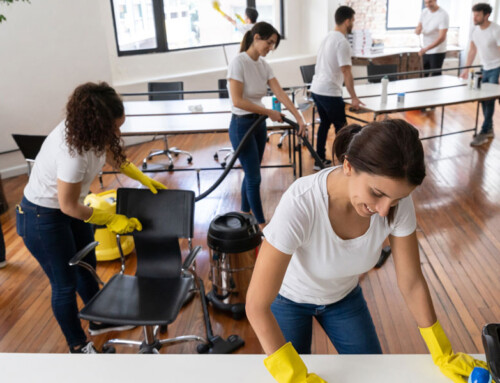Healthier Air Means Healthier Students

Children spend the majority of their time in schools, which, on average, are more crowded than many other indoor spaces. In fact, schools often have four times the population density of a typical office, which can have a major impact on the indoor environment.
Good indoor air quality (IAQ) is an important component of a healthy indoor environment in schools and can contribute to improving students’ health. However, schools face numerous challenges to maintaining good IAQ.
Deferred preventative and regular maintenance, postponement of minor and capital repairs, and delays in major system and component replacements can result in costly issues, including those related to poor IAQ. However, tight budgets, overcrowding, older buildings and facilities, and other various concerns can make managing indoor air in schools difficult and prolong the amount of time students, faculty, and staff have exposure to poor IAQ.
IAQ issues can lead to long- and short-term health problems, such as coughs, eye irritation, headaches, allergic reactions, and in some cases, life-threatening conditions. Continue reading to find out how else poor IAQ can impact education facilities in addition to the students and staff who spend countless hours in these types of facilities.
The Three-Legged Stool
It is helpful to think of the benefits of IAQ management and healthy school environments as a three-legged stool. All three elements—student and staff performance, the physical environment, and occupant health—are equally important, and when combined, support a balanced and healthy school environment.
Student and Staff Performance
Health directly relates to the ability to think, learn, and work. Studies have consistently shown that healthier indoor air helps students achieve higher test scores and helps both adults and children improve in their performance of mental tasks, such as concentration and recall.
A 2015 Harvard School of Public Health research study published in Current Environmental Health Reports found that improved health and productivity correlates with enhanced ventilation. This strengthens the case for schools to develop an IAQ management program with enhanced ventilation strategies, a critical component of a school district’s education development plan.
Physical Environment
Data from the National Center of Education Statistics indicates the average school building in the United States is 57 years old. One quarter of school buildings need extensive repair, and half of all schools report complaints related to IAQ.
The age of a building affects its physical environment, as older buildings are likely to need more frequent repairs. The physical environment of a building also determines the building’s mechanical systems and the methods used to maintain the building and its systems, such as the chemicals used for cleaning and pest control and the handling of pollutants. All of these factors influence the quality of the indoor environment.
Occupant Health
Indoor air pollution, like outdoor air pollution, can negatively affect health if not properly addressed. In fact, the U.S. Environmental Protection Agency (EPA) and its scientific advisory board consider poor IAQ to be one of the top five environmental threats to health. A host of pollutants, allergens, and asthma triggers may be found indoors, including mold, volatile organic compounds (VOCs), radon, lead, asbestos, pesticides, second-hand smoke from tobacco products, and more.
Studies of human exposure to air pollutants conducted by the EPA indicate indoor levels of pollutants may be two to five times—and occasionally more than 100 times—higher than outdoor levels. These levels of indoor air pollutants are of particular concern because most people spend about 90 percent of their time indoors. Additionally, children often are more susceptible to pollutants because they breathe proportionately more air than adults.
The state of a school’s physical environment can significantly influence student health and exacerbate asthma, which is a major health concern in schools and can negatively affect student attendance. Nearly one-in-10 school-aged children has asthma, and the Centers for Disease Control and Prevention (CDC) reports that asthma is a leading cause of school absenteeism.
In some states, school funding is tied to student attendance, and absenteeism caused by asthma can cost districts in those states significant amounts of money. By improving IAQ and acting quickly if an IAQ issue arises, it is possible to protect the health of students and staff, thereby saving the school district money.
Green Cleaning Products
The chemicals found in certain standard cleaning products can cause health problems, and when the products contain VOCs, they can provoke asthma, upper respiratory irritation, nasal congestion, dizziness, and nausea.
Green cleaning products and practices may help avoid these health effects and are a key component of an effective IAQ management program. Green cleaning should be a simple solution, but smart materials selection is not always intuitive. EPA’s IAQ Tools for Schools program offers a list of green cleaning recommendations and identifies what to look for when purchasing environmentally preferable products.
Schools can rely on third-party certifiers to screen and document products that meet the proper green cleaning criteria. Common third-party green product certification programs include Green Seal™, UL GreenGuard and UL ECOLOGO®. EPA’s Safer Choice program offers guidance specific to selecting products for safer and healthier school environments. Third-party certified green products are widely available at costs comparable to those of standard cleaning products.
Green Cleaning Procedures
Effective cleaning and maintenance are key components of green cleaning. This requires:
- Conducting routine inspections of the school environment
- Developing a preventive maintenance plan
- Training cleaning and maintenance staff on protocols
- Ensuring the availability of material safety data sheets
- Damp wiping to remove dust
- Vacuuming with high-efficiency filters.
Additionally, the Healthy Schools Campaign recommends following five simple steps to implement green cleaning in schools:
- Plan your program.
- Select green products.
- Introduce green equipment.
- Adopt green cleaning procedures.
- Share the responsibility with others.
However, data and results from the CDC’s 2012 School Health Policies and Practices Study reveal that only 31.3 percent of all states promoted policies and offered assistance to districts and schools on green cleaning products and practices.
With tight budgets and other resource constraints, a majority of school districts still struggle to provide the training necessary to ensure that all staff members have a functional understanding of the impacts of effective cleaning and maintenance. Less than half (about 44 percent) of districts provide funding for or offer professional development for school faculty and staff on green cleaning products/practices; 63 percent provide funding for these services.
Facility Resources and Solutions
Cleaner, safer, and healthier learning environments for students and staff are achievable through effective IAQ management.
EPA has the resources necessary to train, educate, and support school districts and their staff on green cleaning and IAQ management. The IAQ Tools for Schools Action Kit, the School IAQ Assessment Mobile App, the Framework for Effective IAQ Management, the IAQ Master Class Professional Training Webinar Series, and the Energy Savings Plus Health guide all are offered at no cost on the EPA website. These resources work together seamlessly and are tailored to help coordinate school IAQ assessments and management programs.
This article originally appeared in the October 2017 edition of CMM Magazine.

















